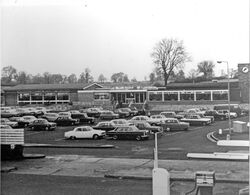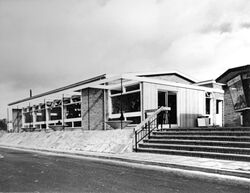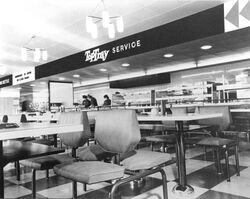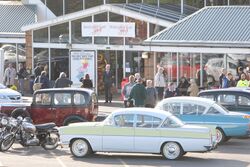History of Watford Gap services

The original catering building.

Watford Gap has lived through the highs and the lows of the motorway service area industry, having been there on day one and still there as the M1 struggles to carry its traffic. The service area's history is detailed here.
Name
Watford Gap's iconic name didn't have a simple birth. It is named after a low lying area of land between hills near the village of Watford in Northamptonshire. This "gap" has been very handy for transport.
In planning, it was called Watford service area. There were concerns that this would be confused with the much larger town of Watford, further down the M1 in Hertfordshire.
It then started to become known as Welton, as it was being built next to what was Welton railway station. Arguably Welton was wrongly named - that village is not nearby - so another name for the service area was requested.
Upon its initial opening in November 1959, operators Blue Boar used the name Watford Village Services. The ministry later decided Watford Gap would be the least confusing name to be used. Customers still arrive at Watford Gap services looking for the town near London, but it's not clear whether that's because the name is confusing or people's navigation is poor.
Location
Watford (the village) has a long-running transport history. It sits off Watling Street, the Roman Road which is today part of the A5 and formed an important pre-motorway route between London and Birmingham. It is also near the Grand Union Canal (again, London to Birmingham), the West Coast Main Line (surprise, surprise, London to Birmingham) and most recently Britain's first motorway, the M1, which originally ran from London to Birmingham and passes through the village. It is a natural place for one of the first service areas.
The site of the service areas, next to the railway and the canal, is on an old farm.
Tendering
See also: The Original Five
Following a last-minute decision to build service areas on the M1, a survey of interested businesses concluded that Redbourn would be the most successful service area, followed by Watford Gap. Redbourn was quickly swapped on the plans for Newport Pagnell.
Details of the project were sent to 64 firms in April 1959, and eight responses were received. The tenders needed to show two transport cafés, one restaurant, a filling station and a repairs bay. Each site needed at least 12 fuel pumps across three islands, with at least 12 toilets. They were examined by the motorway's engineers, alongside experts in finance and catering.
Until the details of service areas had been confirmed, Walls ice cream had been interested in building an ice cream kiosk here, and Motorinns had wanted to build a large hotel. Land at Watford Gap had been designated for a maintenance compound and a police post.
A S Mallin
This bid was rejected almost immediately as the garage firm had no experience in catering. Their financial integrity did not seem strong enough and their submitted plans were not complete.
J Davy Limited
No details are currently available, but the architect was the same as the winning bid at Newport Pagnell.
Banquets Of Oxford Ltd
Sir Owen Williams was very critical of this proposal as it did not allow for any future expansion. It was also poorly laid out.
Knutsford Motors Ltd
This design was criticised for having a small parking area, and distant toilets.
Airborne Catering (Southend-on-Sea) Ltd
This design was considered good but not good enough: the buildings were too small and the layout not good enough.
Motorway Services Ltd
Motorway Services Ltd, the Blue Star and Fortes combination who had also made a strong bid for Newport Pagnell, had made a lucrative financial offer but one which assumed the service area would be very profitable. This was a gamble when no service station had been built yet.
It had been decided no one operator should run more than one of the first batch of service areas, wherever they were built. As their Newport Pagnell bid was so good, this weakened their case for Watford Gap.
Blue Boar

Blue Boar, who ran garages across the region, were one of few smaller firms to make an excellent financial proposal. It was a much safer bid than Motorway Services Ltd, but it was also a different proposal, for a more scaled-back development. They had focused mainly on the fuel and the vehicle repairs, with a very small catering arrangement at the far back of each parking area, with a seating area, kitchen and toilets at each end of a single building block.
The investment cost an estimated £105,000, which would be around £2million in 2025. The fuelling area would be positioned next to the road, where they suggested three brands of fuel should be sold: Shell, Regent and BP. The buildings would be placed far from the road, with each one having a two-storey central block, with a public restaurant on the left and the transport café on the right. There was a kiosk at the public entrance on the left.
Blue Boar owned a towing garage nearby on Dunchurch Road which they were able to use to support a rescue service on the motorway, which was considered important at the time. That facility had a café which would be losing business to the motorway. Their architect was H W Weedon.
Blue Boar won the contract because they made the best offer. However, the Ministry were very aware that supporting a local firm who would be harmed by the opening of the motorway would be a good political manoeuvre. It was also handy that Blue Boar's design was very different to the winning bid at Newport Pagnell - Blue Boar's Watford Gap was much better for HGV drivers. They were one of few operators not interested in selling alcohol, although they later served it with food.
Although the contract included an offer from the Ministry to build a covered footbridge, Blue Boar suggested the cover should be left out and the money spent on ramps instead. This was because there was little public need for the bridge, but it would be used by staff.
Construction

With Blue Boar not chosen as the operator until September 1959, and the motorway due to open in November 1959, Blue Boar were asked to design an emergency toilet block and petrol station so that something would be available when the world's press arrived to experience the new motorway.
Blue Boar wanted the emergency proposal to be compatible with their final plan. Let down by failed deliveries and additional land, only fuel was available when the motorway opened on 2 November 1959 - the toilets opened two weeks late. It was described as "dull and depressing", although many contemporary resources now call it "some brightly coloured sheds". No rent was charged during this period as an appreciation for the early opening.
The development went on to completely miss its target date for full opening in April 1960. It opened in stages, with the northbound restaurant and footbridge opening on 13 September 1960, and the southbound transport café opening on 1 October 1960. An official opening ceremony was attended by Sir Owen Williams, who congratulated Blue Boar on their "enterprise". Despite this, Newport Pagnell was first to open in every respect.
The Ministry of Transport skipped a beat when they saw Blue Boar's proposals for their car park signage. With no existing service areas to copy, Blue Boar designed their own direction system featuring no arrows and some very weak puns.
The outside parts of the service area were larger than expected, and along with the problems encountered building it, causing the cost to the Ministry was significantly higher than the £300,000 budgeted for. Blue Boar spent £159,000 (around £3million in 2025). The contractor was Wilsons.
Operation
Initially 120 people were employed by the service area. Finding reliable staff was difficult and Blue Boar considered building houses to ensure there was local employment available.

Its restaurants were called TopGrill and TopTray (later Pick-a-Platter).
The Times, 1961
A couple of months after opening, Blue Boar were complaining that the service area was too small and needed to be extended. Approximately twice as much traffic was using it as had been predicted. Vending machines were introduced in a desperate bid to manage queues.
Blue Boar were eventually allowed to build a reserve site down the road at Rothersthorpe to reduce overloading. The parking bays at Watford Gap were rearranged, and cars were allowed to park in the coach bays.
The AA stopped endorsing the restaurant in 1963. Complaints peaked, with customers describing its "poor lighting", lack of staff and a 2d charge for paper towels in the toilets. All crockery was disposable, which was supposed to be hygienic, but it also reduced costs and led to further complaints. The National Archives have preserved a polystyrene cup that was posted to the government by an outraged customer.
The waitress service restaurant went entirely self-service in 1965, reducing operating costs and service times, but with further complaints. The forecourt was rebuilt at this time. £66,000 was spent on refurbishment within the first few years (around £1 in 2025) and was not without success: a 1968 review praised the "bright décor", attentive staff and "more imaginative than most" menu, with a good mixed grill on offer and tea for 8d (around 77p).
Overall though, Watford Gap's old age, small footprint, heavy usage and well-known name made it an easy target for criticism. A 1971 independent report described the design of Watford Gap as "poor" and "lacking any quality"; another called "obviously budget-conscious" and "ridiculously small and uncomfortable". In reality it was now no worse than any other at the time, and in the 1970s Watford Gap was actually one of the least complained about service areas, despite it also being (in 1977) the busiest service area in the country.
In 1972 Egon Ronay rated the service area as "appalling", calling it "the worst in nearly every way". He described some of the food as "nasty", criticising the paper plates and the "awful music". When he returned two years later, he said it was "consistently the worst place".
The Mirror were slightly more positive when they visited in 1980, saying it was "a good try" with a "warm welcome". A meal of braised chicken and two veg cost £1.85 (about £8 in 2025), but a carton of yoghurt cost 30p (around £1 in 2025). An AA hotels inspector called it "Britain's most unloved service area" in 1984.
The Guardian wrote in 1985 that the restaurant had "a grim atmosphere in the style of an old British Rail buffet". The seating was mostly dark blue plastic booths. When Which? visited in 1986, they said the restaurant was "small but comfortable", and that the facilities "drab but clean". It was serving about 4,000 people a day.
A 1989 survey by Auto Express described Watford Gap as "a restaurant like a works canteen with mushy baked beans and soggy peas and old and dirty toilets", while a visit from Egon Ronay that year judged it to be the worst service station in the country. His review called it "the ideal place to start your diet" and added that "each dish was astonishingly bad".
A drainage channel was originally provided, running around the northbound service area. This was covered up when the HGV parking area was expanded, most likely in the 1980s. It ran along what's now the trackway behind the northbound building. Expansion of the other parking areas saw most of the traffic islands removed.
Despite the restaurants often being packed, the profits on fuel sales were twice that of the catering sales. The forecourt was branded BP from the 1980s, once the ban on selling one type of fuel was lifted. It remains a BP site to this day, and has now been sold to them. There was a garage building by the northbound lorry park, which was demolished in 2011.
By the 1980s, Watford Gap was one of the first service areas in the country to provide showers for HGV drivers. The expanded parking areas could handle 155 HGVs. It closed during roadworks for several weeks in 1984.
The plan to widen the M1 announced in 1989 caused some confusion. At the time, motorways were normally widened by building a whole new road. It seemed likely that the southbound service area would need to be demolished to facilitate this. As a result, investment in the facilities was put on hold. The Department of Transport suggested that the long-term goal would be for the service area to expand across the canal, onto land that Blue Boar apparently already owned.
Such a major scheme was never needed. When the M1 finally was widened in 2016, it was done so on a much smaller scale, with only very minor changes to the service area's slip roads.
Cultural Impact
From opening, Watford Gap was often believed to be the UK's busiest service area. It held this status until the 1980s, when Hilton Park began to claim the title. The opening of the M40 in 1991 would have conclusively tipped the balance.
Whereas Newport Pagnell was out to impress families, Watford Gap wanted to be cheap and cheerful. This was particularly popular with young men, the demographic which was benefiting most from the new motorway, who nicknamed it 'The Blue Boar'. The transport cafés made a popular meeting point for those using the motorway both for work and socially. Management complained of late night "hooliganism" in 1965. It offered a real blend of cultures, from lorry drivers to celebrities.
The service area was built a few miles from the northern end of the original section of the M1. This caused travellers from London to treat Watford Gap as a gateway to the end of southern England, and this invisible division continues today.
Blue Boar, 1990
Those who live south of the line claim that there is no culture or sophistication north of Watford Gap, and those north of it claim that the line forms the boundary of humour, humility and humanity. People will also refer to things as being "the best this side of Watford Gap". That phrase has gone on to be mistaken for the more well-known Watford in Hertfordshire.
Roy Harper once released a song titled Watford Gap with the chorus "Watford Gap, Watford Gap, a plate of grease and a load of crap" - the full lyrics can be found on Genius. It was on his album 'Bullinamingvase', but was dropped after Blue Boar allegedly threatened to sue. Some sources claim the song was dropped as a member of his EMI board also worked for the service area. Either way, a full version of the song is difficult to get hold of.
A petition was created in 2009 to have 'Watford Gap' added to the Oxford English Dictionary for its association with the north-south divide.
BBC Radio 4 aired a documentary in 2011 called Late Nights at the Blue Boar, in which Peter Paphides discussed the relationship between the service area and music.
As of 2021, some internal documents still say the site is owned by Blue Boar. Roadchef, the actual owner, usually give a shout-out to Watford Gap in their company description, calling it "iconic" and saying they are "proud" to own it.
50th Anniversary Celebrations

See also: 50 Years of Motorway Services
On 2 November 2009 the M1 motorway turned 50 years old. Watford Gap formed a big part of these celebrations, with its birthday celebrated on the same day.
The service area was decorated with balloons and a red carpet, and a fingerpost sign was added to the car park directing people to "the north" and "the south". The transport minister Chris Mole officially re-opened the service area by unveiling an plaque within the service area.
Watford Gap: The Musical
As a throwback to the early days, the RestBite restaurant was selling cups of tea to all visitors for 6p (around 9p in 2025), however people soon discovered that free refreshments were being offered too.
The event was reported on 'BBC Breakfast', 'BBC News at Six', 'Look East', 'Inside Out' and many local BBC Radio Stations. The whole event was held whilst keeping the service area fully operational, so many ordinary customers were surprised to pull in and be guided to a parking space by marshals and meeting a foyer full of people in suits.
On 28 January 2009 Roadchef paid £1,000 at an auction (around £1,567 in 2025) for a book with autographs of various celebrities who visited the service area in the '60s and '70s. They were collected by an ex-Blue Boar employee and scans from this were displayed at the service area as part of the event.
On 16 and 17 October the BBC filmed various scenes all over the service area which were used to create 'Watford Gap: The Musical', a nine-minute musical about "the one-stop round the clock roadside pioneer". It was written by Benjamin Till who, amongst other things, had previously written 'A1: The Road Musical'. The musical can be seen online and was premièred during the celebrations at 7pm in the northbound Costa Coffee to an invited audience. It was simulcast on BBC Radio Northampton, who hosted their drivetime show from the service area, talking to various visitors during the show.
Recent Changes
Watford Gap was where Roadchef trialled WHSmith. It was a success and was soon rolled out across all their service areas.
Pizza Rossa was trialled on the northbound side for a short while within the Fresh Food Café unit, but it was discontinued.
Roadchef's first Carvery Express opened here on the northbound side in September 2015. It was removed in 2017 following an unsuccessful trial.